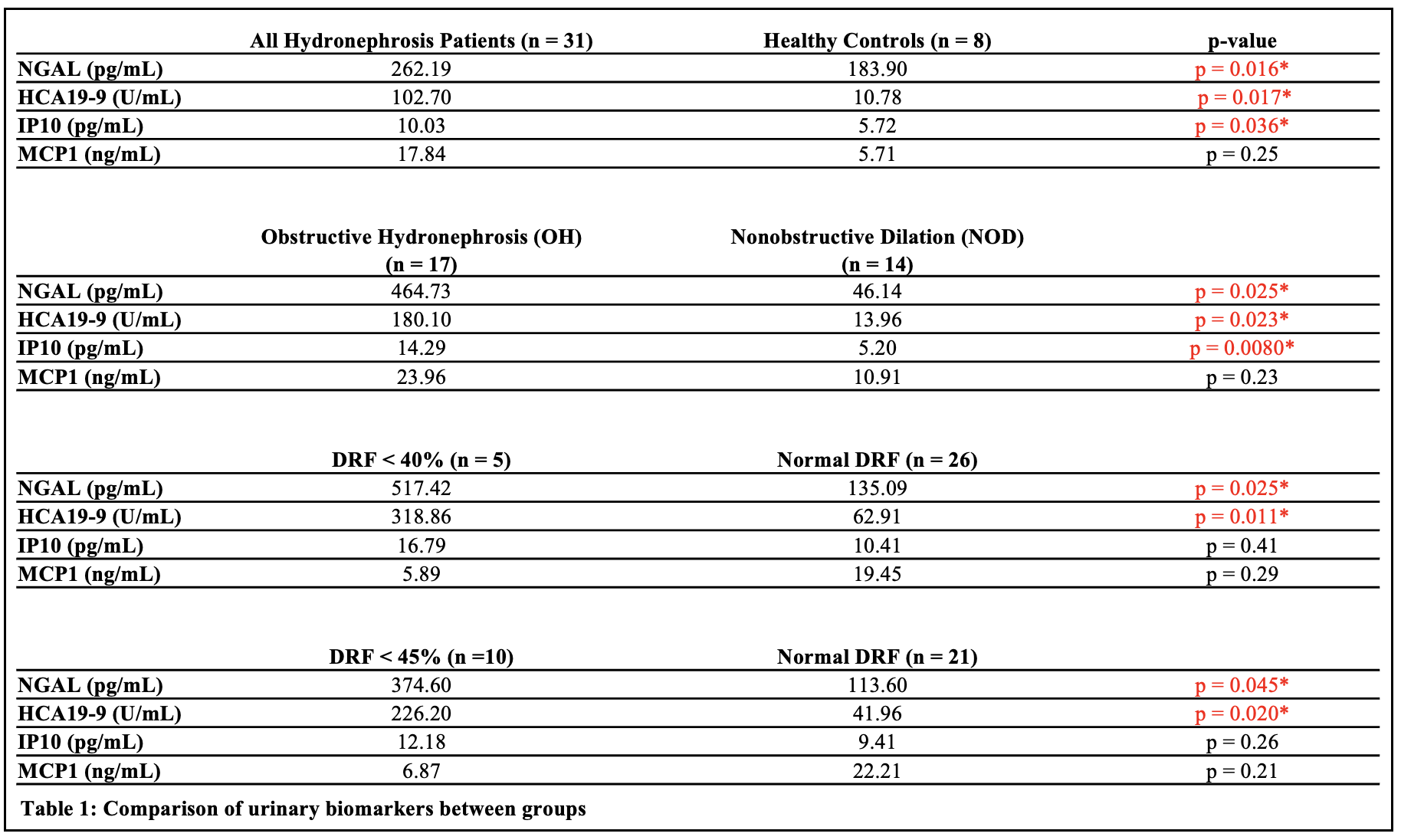Back
Introduction: In patients with unilateral neonatal hydronephrosis, early discrimination between true obstructive hydronephrosis (OH) and nonobstructive dilation (NOD) is challenging. At present, patients are managed on observation protocols with serial ultrasounds and occasional diuretic renography to assess drainage and differential renal function (DRF). Triggers for pyeloplasty are worsening hydronephrosis, decreased DRF, infection, and flank pain, indicative of OH. We evaluate urinary inflammatory biomarkers as an alternative less invasive prognostic indicator for OH.
Methods: Pediatric patients with hydronephrosis and healthy controls were prospectively enrolled in this IRB-approved study. Exclusion criteria were bilateral grade 3-4 hydronephrosis, chronic renal disease, and immunosuppressant medication. Hydronephrotic patients were subcategorized as OH and NOD, based on need for pyeloplasty. Urine samples were analyzed for neutrophil gelatinase-associated lipocalin (NGAL), Human Carbohydrate Antigen 19-9 (HCA19-9), interferon-gamma inducible protein 10 kDa (IP10), and monocyte chemoattractant Protein 1 (MCP1) by enzyme-linked immunosorbent assay (ELISA). Statistical analyses (t-test, Spearman correlation, and logistic regression) were done on SPSS Version 29.0.
Results: Patients with hydronephrosis, and more specifically OH compared to NOD, had significantly higher NGAL, HCA19-9, and IP10 levels (Table 1). NGAL and HCA19-9 levels were significantly higher in patients with decreased differential function. NGAL levels correlated with the presence of OH in a logistic regression model with 94.1% sensitivity and 92.3% specificity. NGAL levels also demonstrated a high negative Spearman correlation (r=-0.893, p=0.007) with the affected kidney DRF.
Conclusions: In this pilot study of hydronephrotic patients, elevated inflammatory biomarker levels correlate with the presence of OH and decreased DRF. In particular, NGAL is a promising biomarker with a strong linear correlation to DRF and the presence of OH. Further longitudinal studies are needed to validate these biomarkers and identify their utility in the clinical management of unilateral hydronephrosis. SOURCE OF
Funding: Stanford Pediatric Innovation Grant

Podium Session
Session: PD37: Pediatrics IV
PD37-12: The Use of Urinary Biomarkers in Pediatric Patients with Unilateral Hydronephrosis to Identify True Ureteropelvic Junction Obstruction
Sunday, April 30, 2023
5:20 PM – 5:30 PM CST
Location: S501C
- KS
Kunj Sheth, MD, BS
Stanford University School of Medicine
Podium Presenter(s)
Introduction: In patients with unilateral neonatal hydronephrosis, early discrimination between true obstructive hydronephrosis (OH) and nonobstructive dilation (NOD) is challenging. At present, patients are managed on observation protocols with serial ultrasounds and occasional diuretic renography to assess drainage and differential renal function (DRF). Triggers for pyeloplasty are worsening hydronephrosis, decreased DRF, infection, and flank pain, indicative of OH. We evaluate urinary inflammatory biomarkers as an alternative less invasive prognostic indicator for OH.
Methods: Pediatric patients with hydronephrosis and healthy controls were prospectively enrolled in this IRB-approved study. Exclusion criteria were bilateral grade 3-4 hydronephrosis, chronic renal disease, and immunosuppressant medication. Hydronephrotic patients were subcategorized as OH and NOD, based on need for pyeloplasty. Urine samples were analyzed for neutrophil gelatinase-associated lipocalin (NGAL), Human Carbohydrate Antigen 19-9 (HCA19-9), interferon-gamma inducible protein 10 kDa (IP10), and monocyte chemoattractant Protein 1 (MCP1) by enzyme-linked immunosorbent assay (ELISA). Statistical analyses (t-test, Spearman correlation, and logistic regression) were done on SPSS Version 29.0.
Results: Patients with hydronephrosis, and more specifically OH compared to NOD, had significantly higher NGAL, HCA19-9, and IP10 levels (Table 1). NGAL and HCA19-9 levels were significantly higher in patients with decreased differential function. NGAL levels correlated with the presence of OH in a logistic regression model with 94.1% sensitivity and 92.3% specificity. NGAL levels also demonstrated a high negative Spearman correlation (r=-0.893, p=0.007) with the affected kidney DRF.
Conclusions: In this pilot study of hydronephrotic patients, elevated inflammatory biomarker levels correlate with the presence of OH and decreased DRF. In particular, NGAL is a promising biomarker with a strong linear correlation to DRF and the presence of OH. Further longitudinal studies are needed to validate these biomarkers and identify their utility in the clinical management of unilateral hydronephrosis. SOURCE OF
Funding: Stanford Pediatric Innovation Grant

